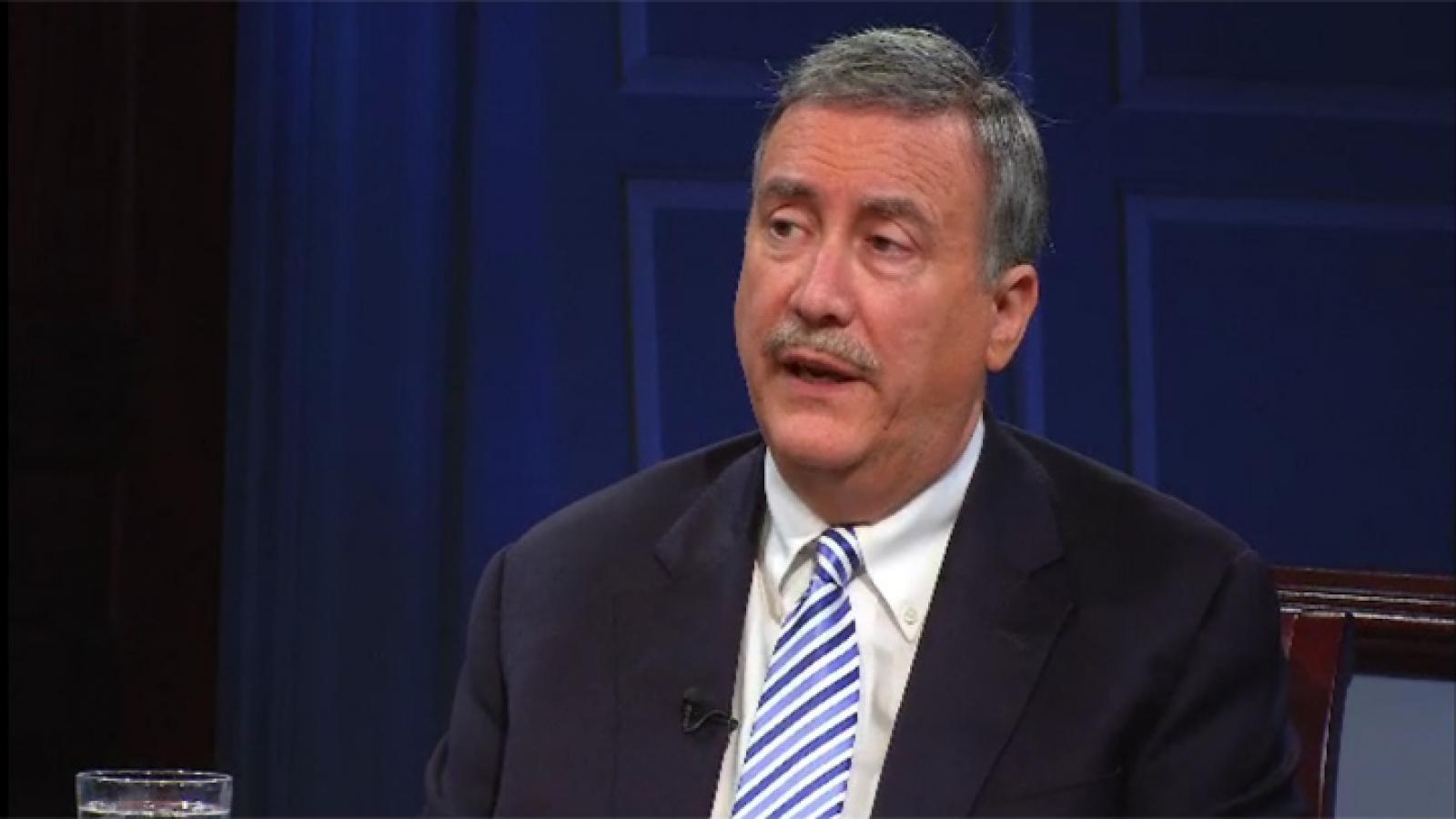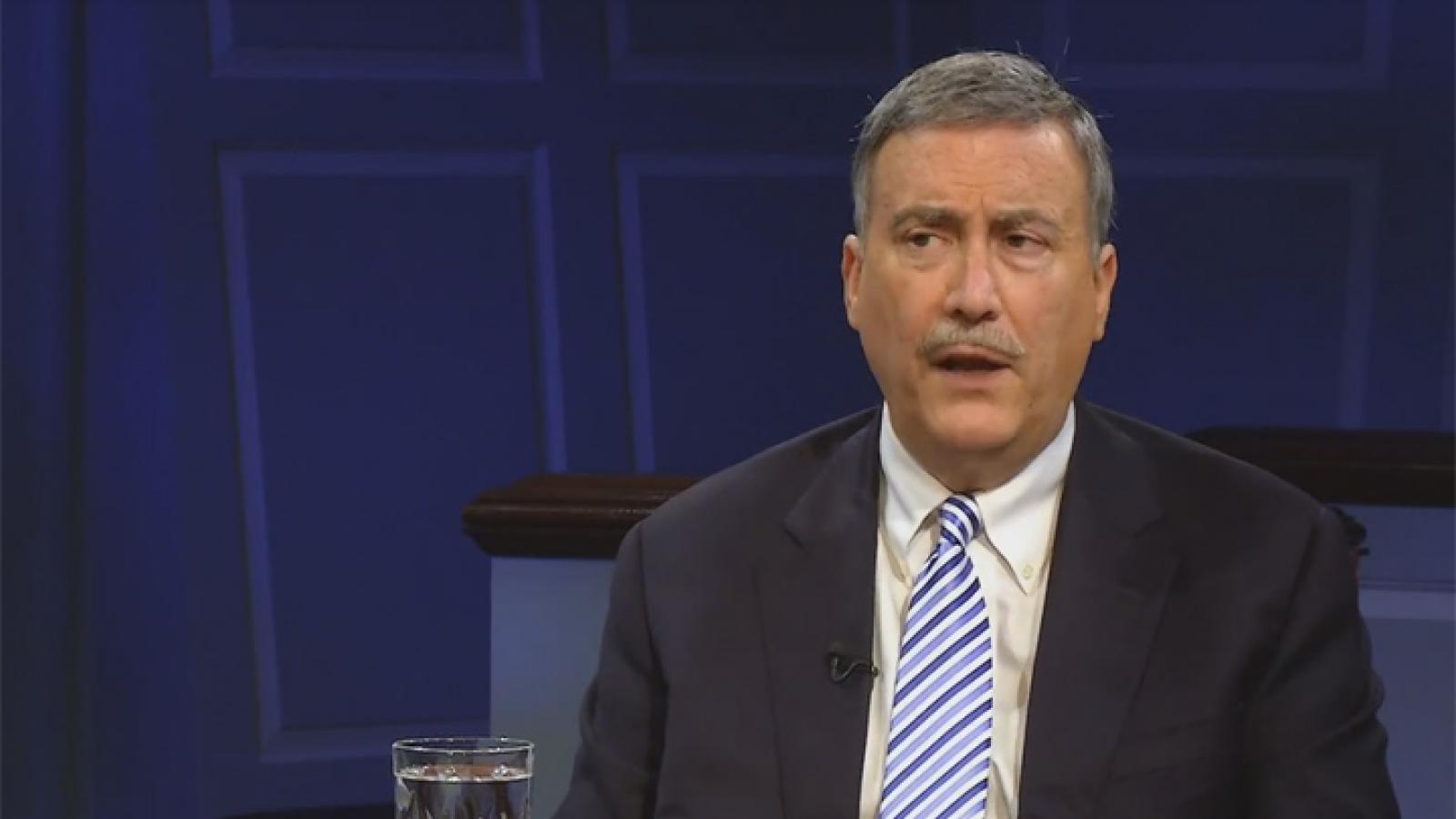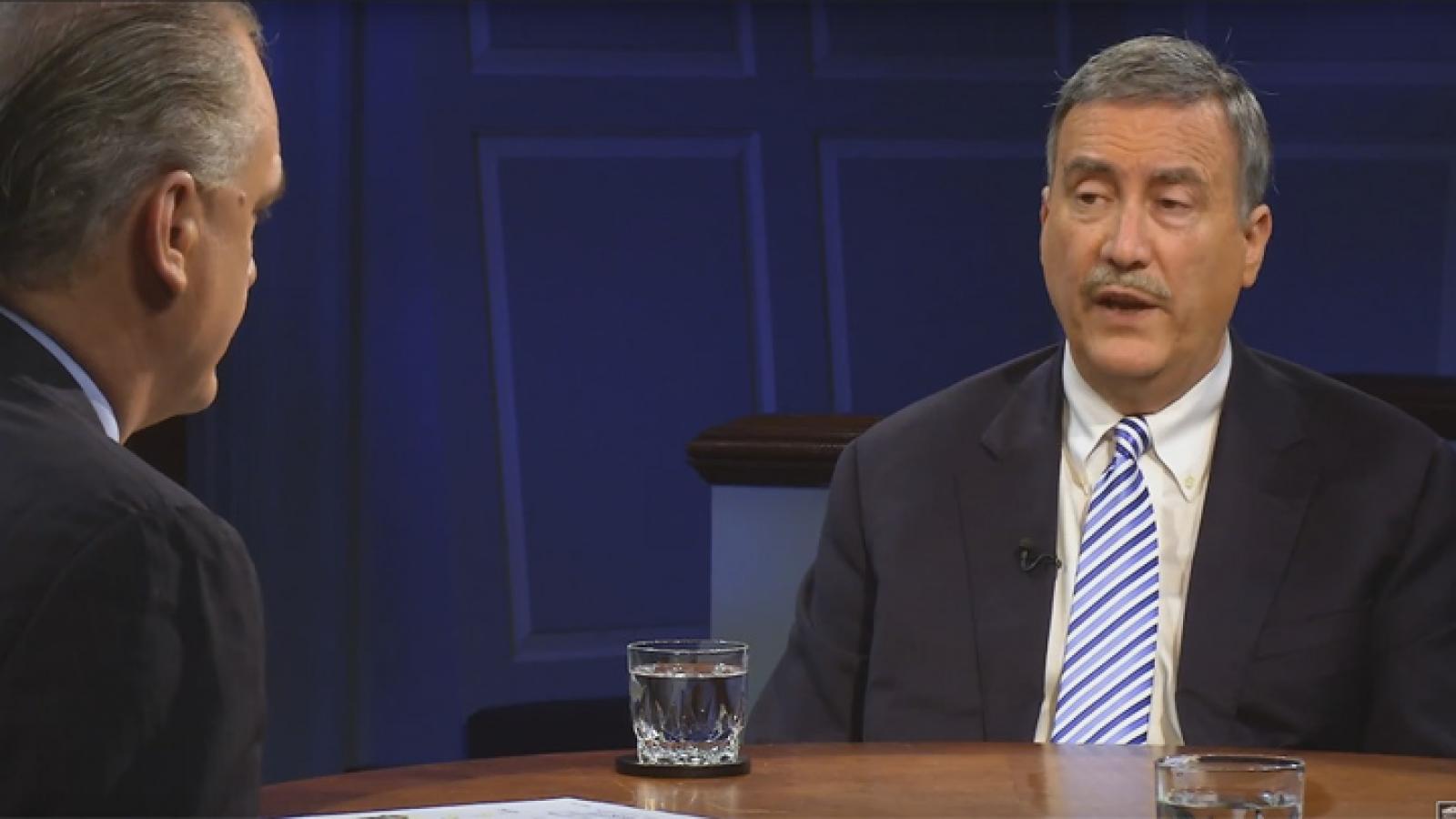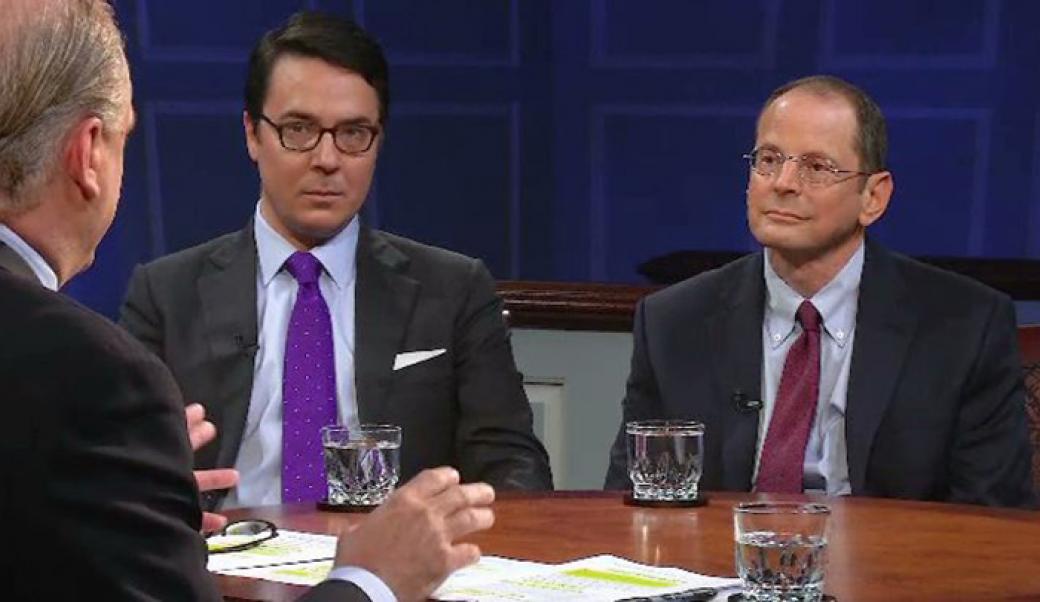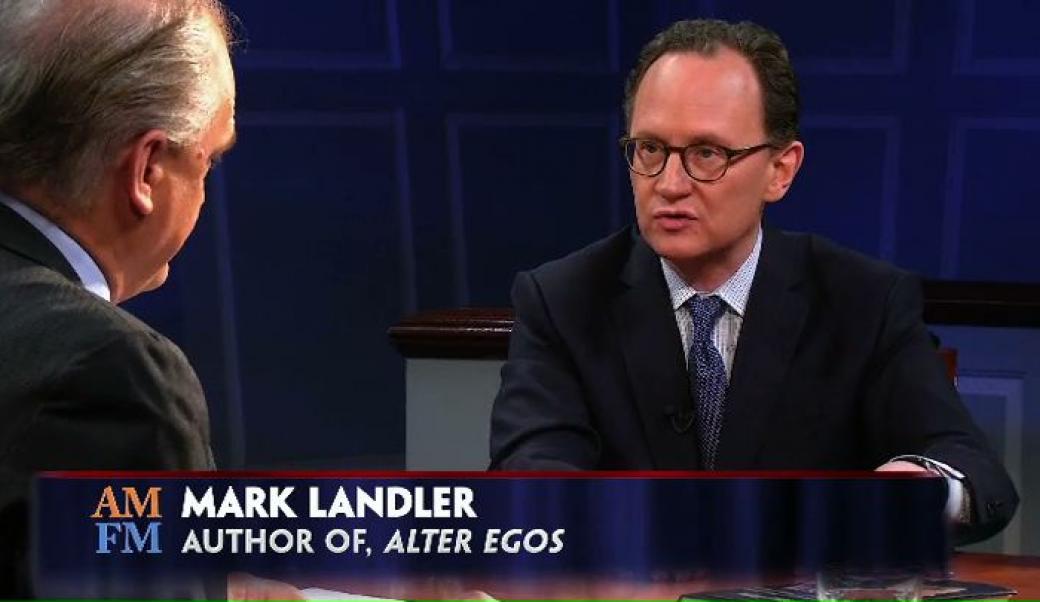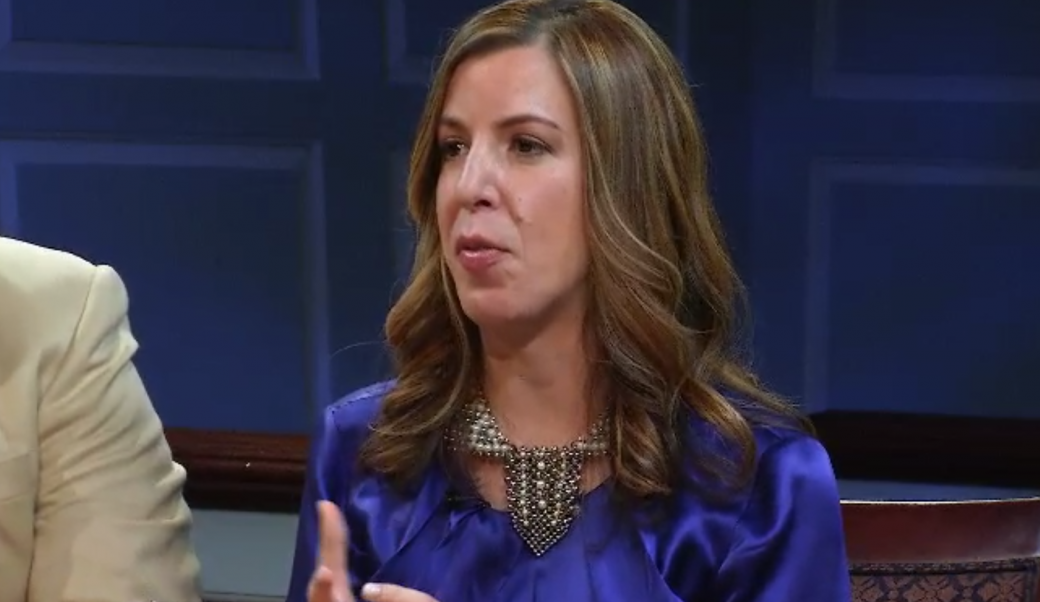About this episode
July 21, 2016
Larry Sabato
In this special Democratic Convention edition of American Forum, UVA political scientist and prognosticator Larry Sabato looks at the past and future of our political conventions and parties.
Politics
An interview with Larry Sabato
Transcript
0:50 Doug Blackmon: Welcome Back to American Forum. I’m Doug Blackmon. The Democratic National Convention is underway this week in Philadelphia. And unless something really really unimaginable has happened since we recorded this program, there’s little suspense about the party nominations. Donald Trump and Hillary Clinton locked those up weeks ago.
FACTOID: The Question: What is convention for when voters hate the parties?
But there are still many questions. What is the purpose of these conventions especially at a time when the most powerful political force is voter animosity, aimed at traditional political institutions such as parties and party conventions? What does a Party platform adopted at the convention matter when a nominee feels beholden to no group or ideology or rejects some of the most basic principles, such as, on the GOP side, support for NATO and free trade agreements? Or for the Democrats, satisfying Bernie Sanders may be the lynchpin to winning in November. Are there versions of this scenario in the past that could help us make sense of what's happening in 2016? Our guest today is the noted political analyst and election prognosticator Larry Sabato. He is the founder and director of the Center for Politics at the University of Virginia, has written or edited two dozen books, most recently a look at the legacy of the 1963 assassination of President John F. Kennedy. He also established a record of remarkably accurate election-outcome predictions long before anyone had ever heard of Nate Silver and his 538 Blog. Thank you for being here.
Larry Sabato: Thank you so much Doug.
2:19 Blackmon: So in a crazy political year like the one that we’re in with all the dynamics that we have seen and the concern on the part of voters about the institutions of our politics. What is the point of the convention like the one this week?
Sabato: Stability I hope. Ah, you certainly want on the calendar certain political events that people can count on and tune into to learn something. If a convention is used well, it’s a week-long infomercial. I’m not certain that’s going to be the case this year but they should be infomercials. They should tell people not just about the candidate but about the party, the party history, the traditions, what the party stands for and most of all what the party will do for the country if elected.
3:08 Blackmon: And so that fits with the traditional history of conventions. I mean going back to the very beginning their primary purpose was to bring together the leaders of the party and the, and a cross section of supporter of the party from across the country, draft a platform, decide on what the principles are right now and select the candidate who can carry that forward. So that’s the core historical purpose.
Sabato: Yes. I think one big change is that the people now really select the nominees in the primaries and caucuses and occasionally we almost went to a contested convention this year, but normally you would expect the voters to select the nominees. And as far as the convention itself, usually the parties have a long time to plan them. It pretty much goes back to President Nixon’s election campaign in 1972 when every single minute had been scripted. And it worked quite well. He did win 49 states.
FACTOID: Nixon crushed McGovern in Huge 520-17 electoral vote landslide
FACTOID: Watergate scandal engulfed Nixon after ’72 election, resigned in ’74
40:03 Blackmon: But so going forward as we come out of this convention, the, with Hillary Clinton as the Democratic nominee but Bernie Sanders having pulled off this really extraordinary accomplishment that he has and sort of against all of the expectations for him, has turned out to be an ideologically important candidate. In a way that’s different from Donald Trump in some respects. He really represents a coherent alternative view as to what the Democratic Party’s approach to the problems of the country ought to be right now. And has successfully pushed a very large population of Democratic voters to share the view that he has. So he’s in a way a more serious philosophically changing figure. But so as we go forward, what does, what does the Democratic Party owe to Bernie Sanders and how then does Bernie Sanders close the deal on all that he has accomplished since the beginning of this?
Sabato: The key for Bernie Sanders is to help Hillary Clinton get elected. It really comes down to that. If she loses, even if it isn’t because of Bernie Sanders, he’s going to be at least partly blamed. He did extend the primary campaign all the way to the end. He clearly caused her unfavorabilities to rise because not so much that his attacks were vicious, I don’t think they were at all. But because she was not able to pivot to the general election and to Donald Trump as quickly as she wanted to. So Sanders’ goal has got to be to be has helpful as possible all the way to November and to energize his youthful core of supporters. He has disproportionate support as those 18 to 35 and they’re the people least likely to vote in November in an average year and I think this, well this isn’t an average year, I think that part of the formula still applies.
FACTOID: Bernie Sanders won 23 states, 13.2M votes in 2016 primaries
6:02 Blackmon: It’s hard to imagine if, if Hillary Clinton had been the definite nominee months and months ago and the democratic primaries had been just exercises in an acclamation and endorsement of her then we would not have the energetic participation of any significant number of these younger voters most likely. So Bernie brought them to the table in a way they wouldn’t have been there. On balance, what do you, what’s the bigger thing Bernie Sanders has done in your view?
Sabato: Well he’ll be a factor in a Democratic victory. I think one other thing here that’s important, he has sharpened Hillary Clinton’s political skills which were awfully rusty after four years as secretary of state. Which while it’s a very political role behind the scenes, in public it tends not to be. And so she had lost her edge from 2008. Now don’t doubt Secretary Clinton would say that she could have used a lot less sharpening. It was a difficult primary season. And she doesn’t know quite how to deal with Donald Trump. No one does. Ah, on the whole though, I think Sanders has helped her more than hurt her though it will take a while to know for sure.
7:11 Blackmon: And the real test will be how effectively he gets out there and keeps those voters mobilized and somehow deals with their frustration which was so evident in the last phase of the primaries.
Sabato: And can he? Can the leader in this case actually motivate voters who are disinclined to vote anyway? And young people are. It takes them a while to settle down. They tend to do it in their 30s and you really have to have a candidate that excites them like Barack Obama did in 2008. Can Hillary Clinton become that candidate? I doubt it, but she has two people President Obama and Senator Sanders who might, might be able to do it for her.
7:50 Blackmon: What would you anticipate the role of President Obama will be in that last phase of the election? Is he going to be a much more ah, ah, dramatically apparent active out on the scene kind of incumbent campaigning for the Democratic nominee more aggressively than maybe has sometimes been the case with a sitting president?
Sabato: President Obama will be all in. He has to be because his agenda and his accomplishments to a great degree will either be revoked or neutralized if Trump is elected president. Trump has made that very clear. And if Trump wins you’re nearly guaranteed to have both a Republican Senate and House. So Republicans would be in charge of everything and I think very quickly they would repeal or substantially change most of what he has done from executive orders to Obamacare. Obamacare, parts of it can’t be undone, but significant pieces would be revised or abolished. And so President Obama has a lot at stake. His legacy is at stake. And he’s made up with Secretary Clinton. And Secretary Clinton served him well as secretary of state for four years. So I think it’s going to be a very energetic campaign led by Obama as much as by Clinton.
FACTOID: Obama endorsed Hillary Clinton in June 2016: “I’m with her”
9:11 Blackmon: So let’s turn for a moment back over to Donald Trump. It’s interesting that in the lead up to these conventions for the longest time the potentially crazy, broken ah convention that there was some anticipation was going to be on the Republican side. It turns out now the Democratic ah the question has been has remained complicated more complicated on the Democratic side than the Republican. What’s the formula for Donald Trump? How is it that he can put together a victory between now and November?
Sabato: He has some narrow pathways to 270. Generally, there by energizing his base which tends to be blue collar white voters in rust belt states, ah, Pennsylvania, Michigan, ah possibly Ohio and Wisconsin. If he gets those states and carries Mitt Romney’s states he would have exactly 270 electoral votes. There’s one other pathway for him that’s at least reasonable on his part. And that would be to carry focus on Florida, Pennsylvania, and Ohio. If he can carry those three, and again all 206 electoral votes that Romney got then he’d have 273 electoral votes. To me those are the two pathways. Now I hear from loads of Trump supporters that he’s going to carry either 49 or 50 states. No. It’s not going to happen. And neither is Secretary Clinton going to carry 49 or 50. We have a well-developed pattern of polarized partisan politics and we will see it in the map again in November.
FACTOID: Romney won 24 states in 2012, mostly from white voters in south.
10:49 Blackmon: But in terms of the message he has to present or to when those lynchpin states that you’ve identified, pull those off, ah he’s got to maximize these blue collar white voters. But that’s probably not enough. There aren’t enough, there aren’t enough of those folks by itself. Or maybe there are?
Sabato: Just enough if he can energize them and pull them out in great numbers and their mobilization does not result in a counter mobilization of minorities. It’s very difficult to do all of these things at once, but it’s possible. After all, a year ago was there a serious analyst who predicted Donald Trump’s nomination? Because I don’t know one. I’m sure I’ll get e-mails now. “Oh, I predicted it.” But I really, people misremember these things. No one thought Donald Trump was going to be the Republican nominee. Given that history, you have to acknowledge that he can do things that other candidates cannot.
11:47 Blackmon: At the same time ah, there was so much of the primary season was about his relationship with the traditional Republican Party. And the convention really is the ultimate expression of conventional politics in many respects. But so now that that’s behind him to what degree does assuaging concerns of the conventional Republican, the old fashioned Republicans out there, how critical is that in this mobilize the blue collar white voter strategy?
Sabato: You see he has to do both. He has to do some other things too besides those two big things but his gamble is that the Republican establishment has no choice. And to some degree he’s right because his core of supporters are so intense that when an establishment Republican challenges him, not only does Trump himself diss that individual, all of his backers do. And they bombard the individual with calls and e-mails and letters and sometime visits. Umm, it’s very unpleasant. And so I think he has essentially if not won them over, then cowed them.
12:58 Blackmon: On election day 2012 Governor Romney’s pollsters came to him at mid-day, you know this story well, and said we’ve done it. We’ve pulled this thing off. You’re the next president. But they had their formulas were wrong in terms of and so they were under overestimating how many white voters were actually going to vote that day. And it turned out there were a lot of missing white voters. Is Trump energizing those missing voters? Is that what’s happening?
FACTOID: Almost 90 percent of Republican voters in 2012 were white, 60 percent of Dems
Sabato: Well he’s energizing some of them in the Republican context. Look, he’s, he got somewhere between 10 and 15 million votes in all the primaries and caucuses. In some places the votes weren’t counted. So let’s say 10 to 15 million votes in the primaries. How many people will vote in November? Somewhere around 135 million give or take a few million, a hundred and thirty-five million. So we’re talking about Donald Trump jumping from a sizeable pond into a giant ocean. And the rules are very different for swimming in this ocean than swimming in the pond.
14:06 Blackmon: So there still remains the question of those missing white voters of 2012. He’s tapping into some of them but A whether they exist at all, because I think there is a debate about that and whether and if they do exist whether he actually can mobilize enough of them and all the other voters that Mitt Romney got in 2012. That’s the big question.
Sabato: And the comparable challenge for Hillary Clinton is to do what would normally happen for a Democratic nominee in 2016. And that is to extend the minority vote. All minorities added together, African Americans, Hispanics, Asian Americans and so on. To equal where the minority vote should be and extrapolating from other election years all minorities together should be about 30 percent of the total turnout. A Democrat should get somewhere between 80 and 85 percent of this vote. Hillary Clinton absolutely needs that vote. She needs a healthy turnout. She needs for again Bernie Sanders supporters and minorities may not be excited about her to get excited.
FACTOID: Obama won 93 percent of black votes in 2012, 71 percent Hispanic, 39 percent white
15:13 Blackmon: So she’s got to have President Obama significantly mobilizing African American voters and to some degree Hispanic voters probably would be a part of that of that mobilization that he would represent and she needs Bernie Sanders to deliver a substantial portion of these younger voters, predominantly white voters that he represents and she’s got to reach out and have maybe more success than what appears to be the case during part of the primary season with white women and women in general. She has not been able, She was not able to energize those voters as much as some might have expected. But are those the three legs that she’s got to pull off?
Sabato: Pretty much. Obviously for her given the dramatic advantage starting out in the electoral college she could potentially do without one of the three legs, but it would be close. Now on the other hand, Democrats can fritter away if they’re number of electoral votes if you take it from the Obama level of 330 plus. You’ll need 270 and so she can lose some states that he won and still get 270 or more.
16:19 Blackmon: And so the flip side of that is if she maximizes all three, if she pulls that off, if she’s got, if Obama is able to energize minority voters ah, Sander younger voters, and she has significant success with women voters, ah then you’re looking at a what would be a potentially an electoral, an electoral catastrophe for the Republicans.
Sabato: Correct. That is correct. It certainly would be an electoral college landslide. In popular vote terms we’ll see. I tend to think we’re so polarized that you’re not going to have a Goldwater or McGovern result. They both got about 38 percent of the vote. I don’t think that’s possible today. I think you’re operating within pretty close parameters, 53 47 something like that. Even when a candidate does very badly they have a hard time doing worse than 46 47 percent.
17:10 Blackmon: Every scenario it’s a 55 45 within those numbers but the outcome could range from a razor thin victory for Hillary Clinton, a razor thin but probably the most difficult to achieve scenario, a razor thin victory for Donald Trump. Or a landslide against Trump that’s something of a catastrophe for the Republican Party.
Sabato: Yeah, yeah I think that’s the range generally speaking. And the electoral college normally exaggerates these election results. That’s probably a good thing. It helps to get a new president off to a good start even if there’s been a very divisive close election. So that may happen as well.
17:48 Blackmon: If we end up in any of these scenarios where Donald Trump does not win but certainly if it’s a resounding defeat for the Republicans, where does that leave both the Republican Party and the system that we’ve operated on for the past you know, 50 years?
Sabato: It worries me in the sense that we need a strong competitive two-party system. You do not want a party and a half system where one party dominates and only loses the White House when they happen to be governing in an election year that has a serious recession or an unpopular war or very serious scandal. That’s not good for the country. We could be headed in that direction depending on what happens in November. Now the Republicans after 2012 did a reasonable thing. The chairman, Chairman Priebus, appointed a very good commission that did an autopsy report on what happened and what ought to be done in the future and their conclusion still applies. Republicans need to do much better appealing to minorities, appealing to women. They’re looking at the future electorate. The country will be majority minority by around 2042. These are facts that you simply can’t campaign away. And so I think the republicans will have to go back to that model. But Doug, the problem for the Republicans is I don’t think the conservatives will accept that because their candidate, at least in the end, Ted Cruz, was the runner up and didn’t get the nomination. I can easily see the conservative wing of the party which is still dominant in many of the states saying, well you see, if you nominated a real conservative, we would have won that election. Just like if you nominated a real conservative instead of McCain in 2008, a real conservative instead of Mitt Romney in 2012. And so they’re going to insist that their theory be tested. And we’ll see what the conditions of an election year are but that could be, underline could, a formula for disaster.
FACTOID: Priebus: “We weren’t inclusive” AFTER 2012 Romney and GOP loss
19:57 Blackmon: It begins to sound like we can end up with a situation that the Republican Party ah becomes in a more acknowledged way essentially a party of two wings. The question then I guess would be whether those two wings of the party could find some basis of compromise to work with each other and be a force to be reckoned with in the way that the Democratic Party did that sort of bargain with the devil in the past of where the progressives were willing to go along with segregation as long as the segregationist wing of the party kept them in power. Is there, I mean is there some sort of parallel between those scenarios?
Sabato: Well there could be and I think what it boils down to is after a number of defeats ah you’re hit over the head with a two-by-four. Once maybe you say it was an accident. Twice you say you were lucky. Three times it’s a pattern you can’t ignore. And that gives you incentive to change. Ideologues often require you know an infinite number of strikes with a two-by-four. You want to have two umbrellas under which most Americans can gather. They choose one, maybe they switch from time to time, but they choose one. And it helps stability and are a superpower and we need that stability. The world depends on us for that stability. This is not a good place to be where we are right now. But times change and 2020 will be a completely different situation, I hope.
21:32 Blackmon: We’ve had a lot of talk about this notion that our politics are more toxic now than ever. Ah they’ve gotten uglier than ever and such. And always historians say well no actually in the past the election of 1800 was just as ugly as this one all of which gets a little bit ah . . .
FACTOID: Newspapers, printed fliers were new technology in 1800 election
Sabato: They didn’t have Twitter in the 1800s.
21:50 Blackmon: Exactly. Amplification of the mean words that were there being said ah that is different from 1800. You’re exactly right. But one thing that certainly seems to be the case now is that there is a a kind of coarseness to our politics that was once not the case. And I think that’s maybe part of the explanation for why and I think Trump, that’s who we have to look at, umm to examine this, that ah that part of the mystery of this campaign year has been he has been able to say things about women, to blame Hillary Clinton for the infidelities of her husband, to use language in a way that in the past people would have even if they agreed with the underlying sentiment somehow would have recoiled a bit from just the fashion in which it was being said. But that perhaps and I’m curious to see if you agree with this theory that this general coarsening of our political dialogue over the last 10 or 15 years, Trump is not the first person to attack a war hero, a military hero and question his credentials. It seemed shocking back when George Bush questioned the military record of an absolute demonstrable war hero like John Kerry but then he got away with it. But it does seem that over these recent years that our tolerance for the kind of sharp language and I think course is really the word. A course way that Donald Trump has been able to evoke some of these darker ah sentiments perhaps that lurk in the American psyche. But is that the explanation? Not so much that our politics is more toxic or that we’re more polarized than ever maybe that’s true but that what’s really happening this year is just that our tolerance for a kind of coarseness in the political dialogue has become huge.
FACTOID: 2004: Bush allies falsely attacked John Kerry’s Vietnam War record
Sabato: Absolutely. And let’s remember that the society became course before politics descended beyond the sewer, beyond the gutter, and that’s where we are in 2016. The phrase that’s often used to describe the forthcoming general election campaign is scorched earth. And I think that may be kind. Ah I don’t think people have any clue what’s really coming. If you’re going to take a foreign trip, I would take it and not watch television if I could. I can’t because of my profession but September and October would be a good time to be away.
24:20 Blackmon: Given what you just said, is everything going to be ok?
Sabato: Well I always say yes because history teaches us that sooner or later it will be ok. But I don’t think what’s happened is good. It’s not good for the country. It’s not good for the world. It’s not good for our society. It’s not good for our politics. And I don’t think we should avoid these tough questions. We need to examine what has happened to have pushed us so low. And what, if anything, can we do to lift ourselves up again?
Blackmon: Larry Sabato. It’s been fun having you. Let’s all pray for our country.
Sabato: Absolutely, long and hard.
Blackmon: We hope you’ll join in this conversation and keep it going wherever you are, with citizens you know who care deeply like you do about our national and political life. American Forum is about dialogue on the defining questions of our society. We also hope you’ll tell us what you think at the Miller Center Facebook page, or by following us on Twitter @douglasblackmon or @americanforumTV or @LarrySabato. To send us a comment, watch other episodes, download podcasts or read a transcript visit us at Millercenter.org/americanforum. I’m Doug Blackmon. See you next week.
